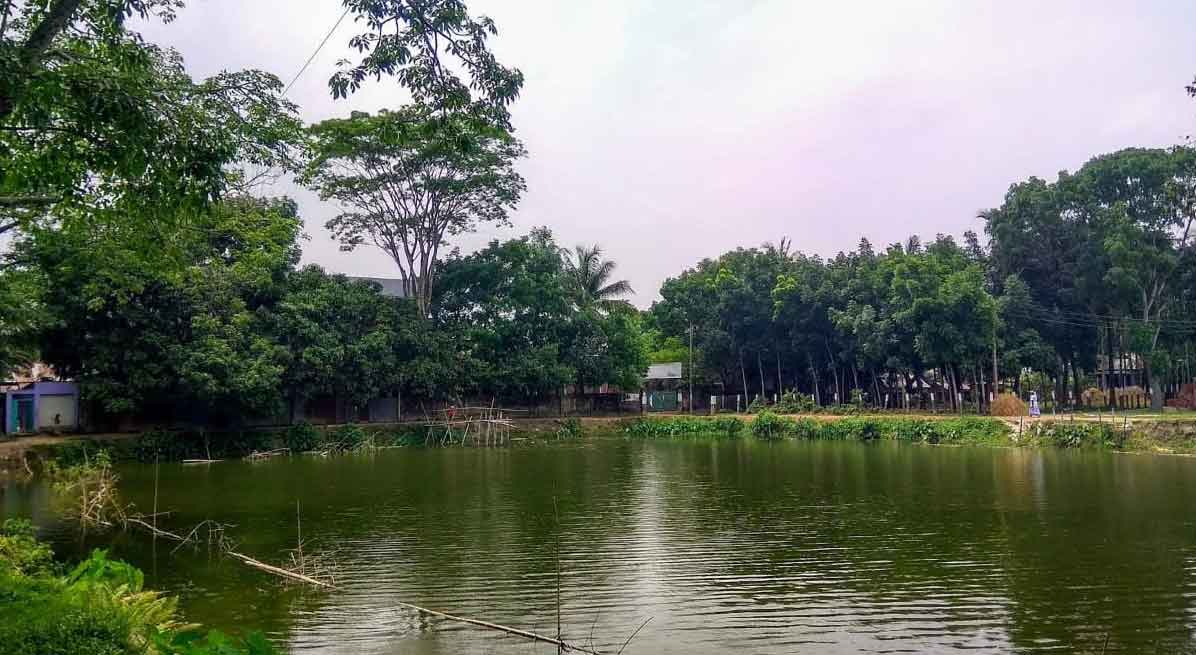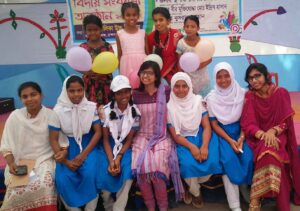
By Mayeda Rashid, PhD, Research Fellow, Monash University, Australia
Introduction

In the context of Bangladesh, where the education system bears the weight of a colonial legacy, I had the privilege of witnessing a remarkable transformation in Tarua, a small village in the Brahmanbaria district. Motivated by personal experiences of disparity and the impact of disasters, I embarked on my PhD project with a vision of empowerment and inclusivity. Through the participation of children as co-researchers, I aimed to bridge the power imbalance between adult researchers (me) and child participants, and the gap between rural and urban areas, providing opportunities for growth, education, and exposure to a world beyond their immediate surroundings. This essay highlights the transformative journey of empowering child co-researchers from Tarua and their pivotal role in transforming a hazardous pond into a vibrant playground through active participation.
The Disparity between Rural and Urban Areas: A Little Background
Bangladesh’s education system, burdened by its colonial history (Ali, 1986; Rahman, Hamzah and Meerah, 2010), reflects a significant disparity between rural and urban areas. With an already overcrowded curriculum, the limited resources, and lack of facilities are more acutely felt in rural communities. Children in these areas face additional challenges such as limited access to quality education, inadequate infrastructure, and a lack of exposure to broader opportunities. The disparity in educational opportunities perpetuates social inequality and hinders the overall development of rural communities (Ahmad, Hossain and Bose, 2005).
In addition to the existing educational disparities, rural communities in Bangladesh are often more vulnerable to the impact of natural phenomena, including floods, cyclones, droughts, and river erosions (Akhter et al., 2015; Bhuiyan et al., 2017; Sarker et al., 2021). These hazards have a devastating effect on the lives and livelihoods of the people in these areas, especially children. Disasters disrupt access to education, damage school infrastructure, and the regular functioning of schools (Akram, Chakma & Mahbub, 2012). Even when the school itself is not destroyed, children’s education is often disrupted because the route to school is either blocked or the school building is co-opted for use as a community shelter (United Nations Children’s Fund, 2011).
As a child growing up in Tarua, I personally experienced the impact of these events. The frequent floods and cyclones would not only disrupt our daily lives but also affect our education. I witnessed firsthand how children would miss weeks or even months of school due to the aftermath of such events. This had serious adverse consequences for our individual growth and development, as well as the long-term intellectual and economic progress of rural communities and the country (United Nations, 2014).
Recognising this disparity, and driven by my personal experience, I was determined to create a platform where rural children could participate as equal partners in research, thereby empowering them and breaking down the barriers that hindered their growth.
Empowering Co-researchers: A Paradigm Shift
I completed my PhD in 2020 from Central Queensland University in Australia. In 2017-18, I went to Tarua where I sought to challenge the traditional power dynamics by treating the children of Tarua as my colleagues. I believed in their potential and actively involved them in the research process. In our research project (yes, it’s ours, not just mine; because it’s as much owned by the child co-researchers as by me), children were not mere subjects, not even so called “research participants”; instead, their voices were valued, and their opinions were sought respectfully.
Methods and Approach
I introduced myself as a learner who had not known where to look for information, and who was therefore looking for it from the children, because they were the experts and had the knowledge. This helped relax the environment, and made the children feel confident and empowered (Davis, 1998; Einarsdóttir, 2007; Graue & Walsh, 1998). I engaged the children as co-researchers by involving them in various activities, ranging from data collection to analysis and, importantly, in documenting the findings by writing a full chapter in my PhD thesis. To minimise the power differential more effectively, I incorporated child-friendly methods and techniques that build on children’s competencies and interests and ensured that the children had support from each other (Barker & Weller, 2003; Brooker, 2001; Eder & Fingerson, 2003; Morrow & Richards, 1996; Mauthner, 1997; Punch, 2002). I aimed to create an environment of equality and respect. This approach not only empowered the children but also challenged the notion that knowledge and expertise reside solely within the realm of academia, produced and access by the so called highly educated adult academics.
Together, we formed a collaborative partnership where the children’s experiences, insights, and perspectives were given equal weight, fostering a sense of ownership and agency. The children felt valued and respected for their contributions, gaining a sense of empowerment in the process.
Collaboration and Mentorship
In addition to my role as the researcher, I facilitated a collaboration between the child co-researchers and my Ph.D. supervisor, the late Professor Kevin Ronan, an esteemed Australian academic. This international collaboration not only provided mentorship and guidance but also opened doors to global connections and diverse ideas for these rural kids. Professor Ronan, along with Professor JC Gaillard, who joined my supervisory panel later, played crucial roles in ensuring that the children’s voices and perspectives were heard at a broader level, strengthening their sense of agency, expanding their horizons, and thus fostering a sense of global citizenship.
Picnics, Friendship, and Bonding
In addition to treating the child co-researchers as colleagues, I also fostered an environment of equality and trust, which naturally opened the door for friendship to develop. Recognising the importance of holistic engagement, I organised picnics and recreational activities for the children beyond our research activities (which too were suggested and led by the children). We laughed, played games, shared meals, and created memories together.
They felt valued not only for their contributions to the research but also as unique individuals with their own interests, stories, and dreams. These shared experiences created a sense of camaraderie and built a strong foundation of trust, which ultimately enhanced the research process by allowing for more open and honest communication, enabling deeper insights and a richer research experience.
Transformation and Impact: A Powerful Story of Empowered Children
Following my return to Melbourne in April 2018, the child co-researchers remained committed to their learning and actively contributed to promoting positive disaster risk reduction (DRR) in their school and community. Despite the physical distance, we maintained communication through a WhatsApp group that included teachers and parents. This platform served as a space for sharing updates on their DRR activities, drawing inspiration from their experiences as co-researchers, and fostering a sense of camaraderie and friendship. They viewed me not as an adult researcher anymore but as a friend, as someone they could share jokes and fun photos with. The WhatsApp group became a valuable avenue for continued collaboration and support in their ongoing efforts towards DRR.
Tarua, situated in a low-lying area, face frequent flooding during the monsoon season, posing significant challenges to the community. The pond, in front of Tarua Girls High School, prone to overflowing, was a hazardous obstacle, obstructing school access for the children.
The flooded pathways made walking impossible, exacerbating the situation due to the absence of adequate transportation. This perilous pond not only hindered education but also posed a grave drowning risk to the entire community. The urgency to address this issue was highlighted when a teacher had a near-drowning incident while crossing the flooded bank on a bike, underscoring the potential dangers faced by the children and emphasising the importance of their DRR mission. The school children, led by the child-coresearcher group, identified this pond as a hazard and shared the incident that happened to their teacher to raise awareness about the risk, aiming for improved school access and community safety. Driven by a sense of empowerment and shared responsibility, the co-researchers, along with their fellow students, village friends, and teachers, rallied together to champion this cause.
They documented the impact of floods on school access, capturing the challenges faced while navigating the hazardous pond. Equipped with compelling evidence and personal stories, the children actively engaged with the school managing committee, local government officials, community members, and other key stakeholders. Through meetings, letters, and presentations, they passionately expressed their concerns about the barriers caused by the overflowing pond. Through their dedicated advocacy and collaborative efforts for more than six months, the child co-researchers successfully convinced government officials to prioritise the issue and allocate resources. As a result, by the end of 2018, the hazardous pond was filled with sand, effectively transforming it into a safe and vibrant playground for the entire community.
Conclusion
By addressing the flooding and drowning hazards, the children not only enhanced school access but also safeguarded the well-being of the entire community. The empowerment of the co-researchers through their participation in my PhD served as a catalyst for transformative change, showcasing the profound impact of genuine participation in research, DRR, and overall community development. The active engagement of the child co-researchers allowed them to develop a sense of ownership and agency, acquiring valuable skills such as problem-solving, critical thinking, communication, and collaboration that will keep benefiting them both academically and in their future endeavours. This experience serves as an inspiring example of how inclusive research and child empowerment can create positive changes and contribute to a more equitable and disaster resilient society.
Acknowledgement
The author gratefully acknowledges the financial support provided by the Australian Government under the Commonwealth Government’s Research Training Program, as well as funding received from Bushfire and Natural Hazards CRC.
References:
Photo caption: The hazardous pond in front of the school, before its transformation, posing challenges and risks to the children and their community.
Disclaimer: The views expressed in this piece are those of the author/s and do not necessarily reflect the views or policies of AIDMI.